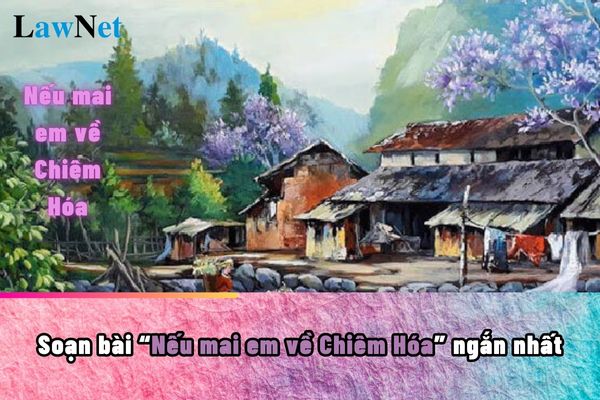What are guidelines on preparing the lesson "Nếu mai em về Chiêm Hóa" for students in Vietnam? Do grade 8 students have the right to study ahead of age?
What are guidelines on preparing the lesson "Nếu mai em về Chiêm Hóa" for students in Vietnam?
"Nếu mai em về Chiêm Hóa" is part of the curriculum for grade 8 students in the Literature program.
Teachers and students can refer to the following guidelines on preparing the lesson "Nếu mai em về Chiêm Hóa":
|
Lesson Preparation Nếu mai em về Chiêm Hóa *Main Emotion: |
*Note: The above information is for reference only./.

What are guidelines on preparing the lesson "Nếu mai em về Chiêm Hóa" for students in Vietnam? Do grade 8 students have the right to study ahead of age? (Image from the Internet)
What are contents of grade 8 Literature in Vietnam?
Based on Subsection 2, Section 5 of the General Education Program on Vietnamese Literature issued together with Circular 32/2018/TT-BGDDT, the knowledge content of grade 8 Literature in Vietnam includes:
(1) CONTENT OF VIETNAMESE LANGUAGE KNOWLEDGE
- Meaning of some relatively common idioms and proverbs
- Nuances of word meanings and word choice
- Onomatopoeic and onomatopoeic words: characteristics and effects
- Meaning of some common Sino-Vietnamese elements (e.g., vô, hữu) and the meaning of words containing these elements (e.g., vô tư, vô hình, hữu quan, hữu hạn)
- Particles and exclamations: characteristics and functions
- Independent components in a sentence: characteristics and functions
- Declarative, interrogative, imperative, and exclamatory sentences; affirmative and negative sentences: characteristics and functions
- Rhetorical devices such as inversion, rhetorical questions: characteristics and effects
- Explicit and implicit meanings of a sentence
- Paragraph types like deductive, inductive, parallel, and coordinated: characteristics and functions
- Text style and genre
+ Narrative text: writing about a trip or a social activity
+ Expressive text: six-line and seven-line poems; a paragraph recording thoughts about a six-line, seven-line poem
+ Argumentative text: thesis, arguments, and evidence; a discussion on a societal issue; an analysis of a literary work
+ Informative text: objective information, subjective opinions, and purpose of the text; explanatory text for a natural phenomenon; introduction of a book; petition text
- National and local terminology: function and value
- Social jargon: function and value
- Non-verbal communication tools: images, figures, charts...
(2) CONTENT OF LITERATURE KNOWLEDGE
- Imagination in literary works
- Title and titling of texts
- Topic and theme, ways to identify theme; structure
- Storyline, context, characters, and language in laughter and historical stories
- Single-threaded and multi-threaded plotlines
- Main artistic techniques of satirical poetry
- Some elements of the rules of the seven-character, eight-line, and four-line Tang poetry: layout, connection, law, rhyme, rhythm, and contrast
- Some formal elements of a poem: words, imagery, layout, emotional flow
- Conflict, action, characters, dialogue, and satirical techniques in literary scripts (comedy)
- Some formal elements of free verse (six, seven characters): number of lines, characters, rhyme, rhythm
- Reader and personal reception of a literary text
- Content reflection and the author's perspective on life and people.
Do grade 8 students in Vietnam have the right to study ahead of age?
Pursuant to Article 35 of the Regulations on the lower secondary school, upper secondary school, and multi-level school issued together with Circular 32/2020/TT-BGDDT, ggrade 8 students have the following rights:
(1) Entitled to equal access to comprehensive education, ensured conditions regarding time, facilities, hygiene, and safety to study in class and self-study at home, information about their study and practice, and use of equipment and facilities for educational, cultural, and sports activities according to regulations.
(2) Respected and protected, treated equally and democratically, with the right to appeal to the school and educational management levels about decisions concerning themselves; the right to transfer schools when justified, following current regulations; the right to study before age, skip grades, study at an age older than the prescribed age according to Article 33 of the Regulations on lower secondary schools, upper secondary schools, and multi-level schools issued together with Circular 32/2020/TT-BGDDT.
(3) Participate in activities to develop talents in subjects, sports, and arts organized by the school if qualified.
(4) Receive scholarships or other allowances as prescribed for students eligible for social policies, those with life difficulties, and those with special talents.
(5) Eligible for transfers according to regulations; transfer procedures implemented according to the regulations of the Minister of Education and Training.
(6) Enjoy other rights as prescribed by law.
One of the rights of grade 8 students is to study before age, skip grades, and study at an age older than the prescribed age according to Article 33 of the Regulations on lower secondary schools, upper secondary schools, and multi-level schools issued together with Circular 32/2020/TT-BGDDT.
Thus, grade 8 students have the right to study before age if they meet the conditions as prescribed.

